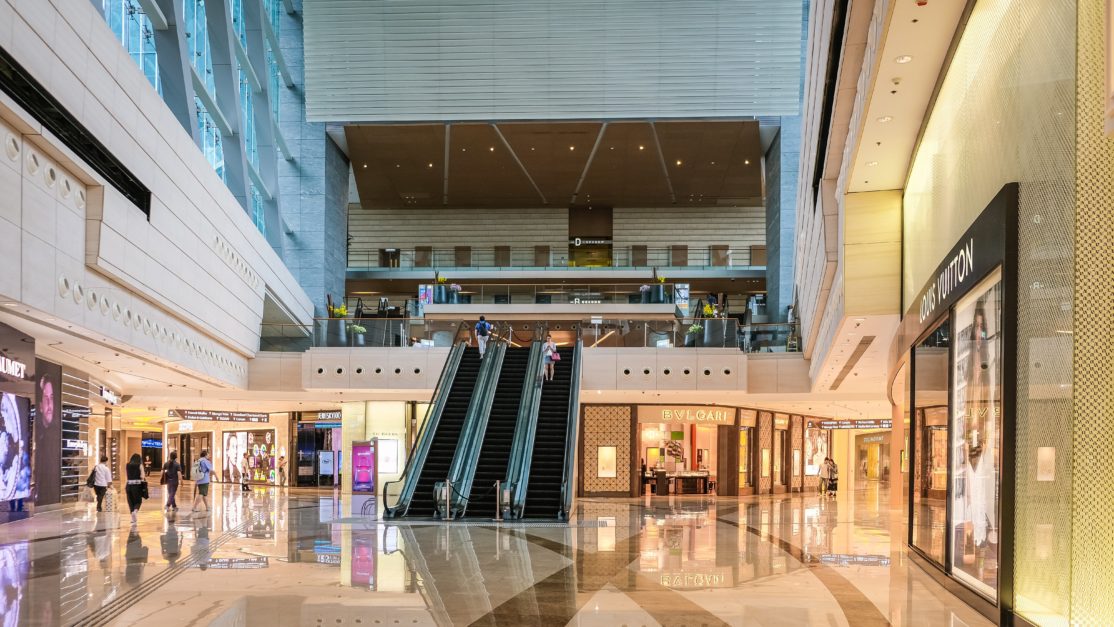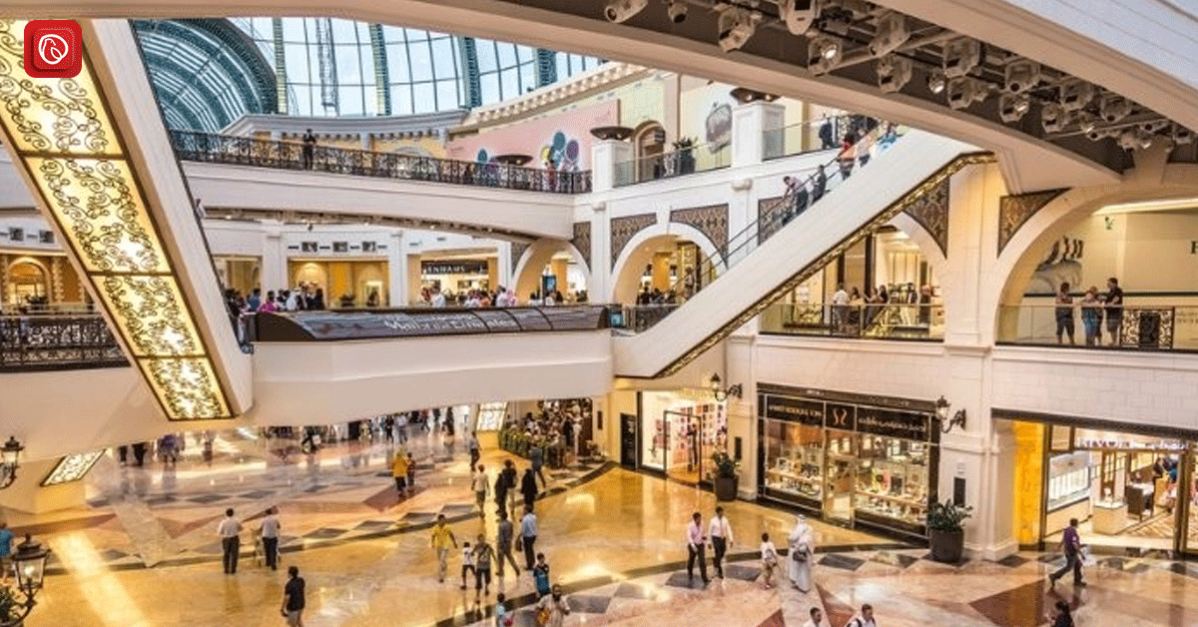In recent years, sustainability and energy efficiency have become increasingly important for businesses across various industries, and shopping centers are no exception. Shopping centres consume a significant amount of energy, making them a prime target for energy management initiatives.
Implementing energy management strategies not only reduces energy consumption and costs but also has positive environmental and social impacts.
Graana.com has prepared a detailed guide on energy management in shopping centres, including benefits and strategies.
Energy Consumption in Shopping Centres

Shopping centres are large commercial buildings that consume significant amounts of energy to operate. The energy consumed in shopping centres is used for various purposes. It includes lighting, heating, ventilation, air conditioning, escalators, elevators, and other equipment used in the stores within the shopping centre.
Here are some of the ways in which energy is consumed in shopping centres:
Lighting
Lighting is one of the largest energy consumers in shopping centres. The lighting in shopping centres is usually kept on for long hours, and it is essential to provide sufficient illumination to enhance the shopping experience. The lighting systems in shopping centres include general lighting, display lighting, and emergency lighting.
Heating, Ventilation, and Air Conditioning (HVAC) Systems

Shopping centres require HVAC systems to maintain comfortable indoor temperatures for shoppers and store occupants. HVAC systems consume a considerable amount of energy in shopping centres, especially during peak demand periods.
Escalators and Elevators

Shopping centers are multi-story buildings, and they require escalators and elevators to facilitate movement between the floors. These systems consume significant amounts of energy due to the high amount of power required to move people and goods between the floors.
Other Equipment
Shopping centres use various types of equipment, such as refrigeration systems, cooking equipment, and office equipment, which consume energy. The energy consumption of these systems depends on the type of equipment and its usage patterns.
Benefits of Energy Management in Shopping Centers
Following are the advantages of incorporating energy management systems in shopping malls:
- Cost savings through energy efficiency
- Reduction in carbon footprint and environmental impact
- Improved customer experience
- Compliance with energy regulations and standards
Cost Savings Through Energy Efficiency
One of the most significant benefits of energy management in shopping centers is cost savings through energy efficiency. By implementing energy-efficient measures, shopping centre owners and operators can reduce their energy consumption and lower their energy bills. The cost savings achieved through energy efficiency can be significant, especially for large shopping centres with high energy consumption.
In addition to direct cost savings, energy management can also result in indirect cost savings. For example, energy-efficient lighting can reduce the need for frequent bulb replacements and maintenance, reducing maintenance costs. Moreover, energy efficiency can improve the lifespan of equipment and reduce the need for replacements, resulting in long-term cost savings.
Reduction in carbon footprint and environmental impact
Energy management in shopping centers can also lead to a reduction in their carbon footprint and environmental impact. Shopping centres are known to be large consumers of energy, which is predominantly generated from fossil fuels that release greenhouse gases into the atmosphere, contributing to climate change.
By reducing their carbon footprint and environmental impact, shopping centres can contribute to global efforts to mitigate climate change and create a more sustainable future.
In addition, reducing the environmental impact of shopping centres can also improve their reputation and attract environmentally conscious customers who prioritise sustainability in their purchasing decisions. It can lead to increased sales and profitability for the shopping centre.
Improved Customer Experience
Energy management in shopping centres can greatly improve the customer experience by creating a more comfortable and inviting environment. By implementing energy-efficient measures such as lighting upgrades and HVAC controls, shopping centres can improve the quality of lighting and temperature control, creating a more pleasant shopping experience for customers. Improved indoor air quality and noise reduction can also create a healthier and quieter environment, further enhancing the customer experience.
In addition to physical improvements, energy management initiatives can also involve working with retailers to encourage energy-efficient practices. By promoting sustainability and energy efficiency, shopping centres can create a consistent and enjoyable shopping experience for customers who prioritise these values in their purchasing decisions. It can lead to increased customer loyalty and attract new customers who value sustainability.
Compliance With Energy Regulations and Standards
Compliance with energy regulations and standards is another important benefit of energy management in shopping centres. Governments and regulatory bodies around the world are increasingly implementing energy efficiency regulations and standards to reduce energy consumption and greenhouse gas emissions.
By complying with these regulations and standards, shopping centres can avoid penalties and fines and maintain a positive reputation.
Energy Management Strategies in Shopping Centers
Following are the strategies for incorporating energy management in shopping malls:
- Implementing energy-efficient lighting systems
- Installation of HVAC systems with energy-saving features
- Use of renewable energy sources
- Energy monitoring and management systems
- Engaging tenants and stakeholders in energy management
Implementing Energy-Efficient Lighting Systems
Implementing energy-efficient lighting systems is one of the most effective ways to reduce energy consumption in shopping centers. Lighting accounts for a significant portion of a shopping centre’s energy consumption, making it an ideal area for energy-saving improvements.
Here are some energy-efficient lighting systems that shopping centres can implement:
- LED Lighting: LED lighting is a highly energy-efficient lighting solution that can reduce energy consumption by up to 80% compared to traditional lighting. LED lighting also has a longer lifespan than traditional lighting, reducing maintenance costs and improving overall sustainability.
- Daylight Harvesting: Daylight harvesting systems use sensors to measure the amount of natural light in a space and adjust the lighting levels accordingly. By using natural light whenever possible, daylight harvesting can significantly reduce energy consumption while creating a more comfortable and natural lighting environment.
- Occupancy Sensors: Occupancy sensors detect when a space is occupied and adjust the lighting levels accordingly. This can help reduce energy consumption by automatically turning off lights in unoccupied spaces.
- Timers and Dimmers: Timers and dimmers can be used to control the lighting levels and duration of operation, reducing energy consumption when lighting is not needed.
Installation of HVAC Systems With Energy-Saving Features
Installing HVAC (heating, ventilation, and air conditioning) systems with energy-saving features is another effective way to reduce energy consumption in shopping centres. HVAC systems typically account for a significant portion of a shopping centre’s energy consumption, making them a prime target for energy-saving improvements.
Here are some energy-saving features that shopping centres can consider when installing HVAC systems:
- High-Efficiency HVAC Units: High-efficiency HVAC units are designed to use less energy while providing the same level of comfort as traditional HVAC units. By replacing old and inefficient HVAC units with high-efficiency units, shopping centres can significantly reduce energy consumption and lower energy costs.
- Variable Refrigerant Flow (VRF) Systems: VRF systems are highly efficient HVAC systems that use a variable-speed compressor to adjust the refrigerant flow according to the heating and cooling needs of a space. This can significantly reduce energy consumption while providing more precise temperature control.
- Energy Recovery Ventilation (ERV) Systems: ERV systems recover and reuse the energy from the exhaust air to preheat or pre-cool incoming fresh air. This can significantly reduce the energy needed to heat or cool space and improve overall energy efficiency.
- Building Automation Systems (BAS): BAS can be used to control and monitor HVAC systems, optimising energy consumption and reducing waste. By using BAS, shopping centres can adjust HVAC settings based on occupancy, temperature, and other factors, improving energy efficiency and reducing energy costs.
Use of Renewable Energy Sources
The use of renewable energy sources is another effective way to reduce energy consumption and greenhouse gas emissions in shopping centres. Renewable energy sources, such as solar, wind, and geothermal, are sustainable and environmentally friendly alternatives to traditional fossil fuels.
Here are some ways in which shopping centres can use renewable energy sources:
- Solar Panels: Installing solar panels on the roof or facade of a shopping centre can generate clean energy and reduce reliance on traditional power sources. Solar panels can also provide shade and reduce cooling costs during the summer months.
- Wind Turbines: Installing wind turbines on the roof or in the vicinity of a shopping centre can generate clean energy and reduce reliance on traditional power sources. Wind turbines can also serve as a visual statement of a shopping centre’s commitment to sustainability.
- Geothermal Systems: Geothermal systems use the natural temperature of the earth to heat and cool buildings, reducing energy consumption and greenhouse gas emissions. Geothermal systems can also provide hot water for the shopping centre’s use.
- Energy Storage Systems: Energy storage systems can be used to store excess energy generated by renewable energy sources and provide backup power during periods of low or no energy production.
Energy Monitoring and Management Systems
Energy monitoring and management systems are software tools that allow shopping centres to track and manage their energy consumption in real time. These systems provide valuable data and insights into how energy is being used in the shopping centre, allowing managers to identify areas of high energy consumption and implement energy-saving strategies.
Engaging Tenants and Stakeholders in Energy Management
Engaging tenants and stakeholders in energy management is an essential part of improving energy efficiency in shopping centres.
Here are some ways in which shopping centres can engage their tenants and stakeholders in energy management:
- Education and Training: Providing education and training to tenants and stakeholders can increase awareness and understanding of energy conservation and sustainability. This can include workshops, training sessions, and informational materials on energy-efficient practices.
- Incentives: Providing incentives to tenants and stakeholders can encourage them to adopt energy-efficient practices. This can include financial incentives, such as discounts or rebates on energy-efficient equipment, or non-financial incentives, such as recognition for energy-efficient practices.
- Communication: Open communication channels between the shopping centre management and tenants can help identify areas of concern and opportunities for improvement. Shopping centre management can use newsletters, social media, and other communication channels to keep tenants and stakeholders informed about energy-saving initiatives and progress.
- Collaboration: Encouraging collaboration between tenants and stakeholders can lead to more significant energy-saving initiatives. For example, tenants could work together to implement shared energy-saving practices, such as turning off equipment when not in use.
- Feedback and Suggestions: Encouraging feedback and suggestions from tenants and stakeholders can help identify areas for improvement and increase engagement in energy management initiatives. Shopping centre management can use surveys or feedback forms to gather input from tenants and stakeholders.
Challenges in Energy Management in Shopping Centres
Following are different energy management challenges in shopping malls
- Lack of awareness and understanding of energy management
- High initial investment costs
- Limited access to capital for energy efficiency projects
Lack of Awareness and Understanding of Energy Management
One of the key challenges in energy management in shopping malls is the lack of awareness and understanding among the stakeholders involved. Many shopping mall owners and tenants are unaware of the potential benefits of energy management, such as cost savings, improved comfort, and reduced environmental impact.
The lack of awareness often leads to a lack of commitment and support for energy efficiency projects. The owners and tenants may not prioritise energy management due to a lack of knowledge about its importance or may underestimate the potential savings that can be achieved through energy efficiency measures.
Furthermore, these malls are often managed by multiple parties, including owners, tenants, and property managers, which can create communication and coordination challenges. This can make it difficult to establish a common understanding of energy management goals and strategies, resulting in a lack of coordinated action to improve energy efficiency.
High Initial Investment Costs
Another major challenge in energy management in shopping centers is the high initial investment costs of energy efficiency projects. Upgrading to more efficient lighting, heating, ventilation, and air conditioning (HVAC) systems, for example, can require significant upfront capital investment.
Shopping centre owners and tenants may be hesitant to invest in energy efficiency projects due to concerns about the return on investment and the potential impact on their bottom line. Additionally, financing options for energy efficiency projects may be limited, and the payback period for these investments can be long, which can further discourage stakeholders from investing in energy efficiency.
Limited Access to Capital for Energy Efficiency Projects
Limited access to capital is another challenge in energy management in shopping malls. Even if shopping mall owners and tenants understand the benefits of energy efficiency projects, they may not have the necessary funds to implement them.
Many shopping mall owners and tenants operate on tight budgets and may not have the financial resources to invest in energy efficiency projects. Additionally, banks and other financial institutions may be reluctant to lend money for energy efficiency projects due to the perceived risk and the long payback period for these investments.
For more related information, visit Graana Blog.




